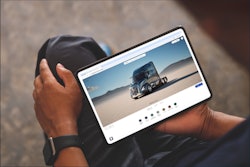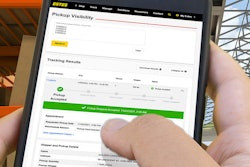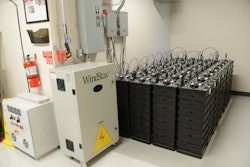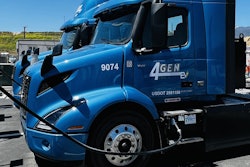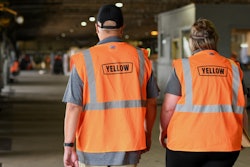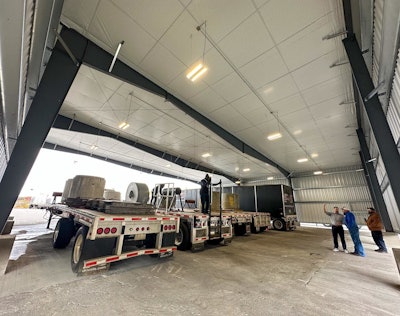
CCJ Innovators profiles carriers and fleets that have found innovative ways to overcome trucking’s challenges. If you know a carrier that has displayed innovation, contact CCJ Chief Editor Jason Cannon at [email protected] or 800-633-5953.
Feeling in control of ones own destiny can feel empowering but, often at the mercy of dispatchers and load schedules, that's a feeling many truck drivers rarely know when tugging a load. It is, however, something many of them desire.
According to CCJ's most recent What Drivers Want survey, the ability to choose their own routes and hauls would prompt 22% of surveyed company drivers and leased owner operators to leave their current fleet for a new motor carrier.
Rushville, Indiana-based carrier Fraley and Schilling, alongside app developer Eleos, created a user-friendly system that allows drivers to assign themselves to a load with just a few taps. About 70% of the company’s freight is flatbed and the fleet operates over 650 power units. In addition to flatbeds, the company has dry vans, pneumatic tankers, and intermodal assets.
Rolled out in May this year, drivers self-managing their load assignments has streamlined driver-dispatcher communications and increased job satisfaction.
The ability to self-dispatch a readily available load not only empowers the driver, it clears a logjam of sometimes incorrect data flowing into the back office. Nicky Cupp, Fraley and Schilling’s director of continuous improvement, said when the company’s drivers arrive at select customer facilities before or after hours, often assigned loads were not ready and rather have drivers wait, customers would give them a different load going to the same destination.
Drivers could call or message their fleet managers to update the load information (if the office was open), but Cupp said tracking change was complicated afterhours. Without necessary updates, bills of lading (BOLs) and other load documents did not match the order details in the transportation management system (TMS) and customers rejected payment for loads with the wrong documents, leading back-office staff to coordinate with dispatch to untangle and correct the issue.
"This inconsistency caused a cascade of issues," Cupp said. "So when the payment processor rejected the load back to billing due to discrepancies, the back office had to push the lead back to dispatch. Dispatch in turn had to drop everything and sort through the jumbled up mess. Hours were spent reacting to the lack of communication causing additional delays. So this meant that dispatch was not available to assist drivers with their current loads leading to even more frustration and confusion. The cycle continued resulting in lost revenue when we lost track of loads."
Do-it-yourself approach
The customers are set up for Auto Accept on EDI, which means Fraley and Schilling's operations team does not have to accept the load or build it in the TMS.
To self-dispatch, drivers open the app, click “get load,” and select the customer. Next, they type in the reference number.
The system verifies that the load number is not already assigned to another driver and matches a load in the system for the shipper. Drivers also type in their unit and trailer numbers. When they submit the form, the system assigns the load to the driver and starts the trip, saving them an extra step.
If the driver misses a digit, the app says the load is unavailable for self-dispatch and asks the driver to verify the number. The driver's fleet manager also gets an email to review the entry and determine why the load could not be self-dispatched. This information allows managers to call or message the driver to resolve the issue proactively.
Drivers use the fleet’s custom app on personal smartphones and in-cab tablets. With the integrated self-dispatch feature, drivers no longer must wait for dispatchers to assign loads. They can arrive at customers and select loads ready to go, reducing idle time and increasing productivity.
The driver arrives/departs, updating the TMS and EDI auto updates the customer with arrivals/departures.
"This entire shipment lifecycle from tendering through payment can be done with very few touches," Cupp said.
The billing team spends "less than one minute," Cupp said, invoicing the load. The customer is set up for Auto Pay, so they initiate payment as soon as EDI closes the load out in their system.
Cupp said the self-dispatching feature was developed for four customers, impacting 20 drivers assigned to accounts with approximately 20,000 loads per year. The feedback from drivers and dispatchers so far has been positive.
“Dispatchers say it's quicker to train the driver on the new system than to fix one mistake the old way,” she said.
Drivers have complete control over the length of their work day, within hours of service parameters, and Cupp said some drivers have been motivated to not spend as much time at the shipper/consignee in favor of finishing their day a little earlier.
"Some drivers have been able to complete loads more efficiently, enabling them to fit in an extra load at the end of the day," she added.
Drivers also have more control over the accuracy of their pay by making sure that every load they complete each day is accounted for within the F&S Connect driver app. Previously, Cupp said they were dependent upon the operations team to reassign loads, "and this did not always mirror what the driver actually did each day."
Fraley and Schilling has an expansive network of servers and web applications that are all interconnected using robotic process automation (RPA). RPA supports its internal chatbots, customer invoice delivery and communications, transmitting PODs electronically via EDI and resolving errors on our network without its team having to get involved.
The CCJ Innovators program is brought to you by Bestpass, Chevron Delo, Comdata and Freightliner Trucks.



